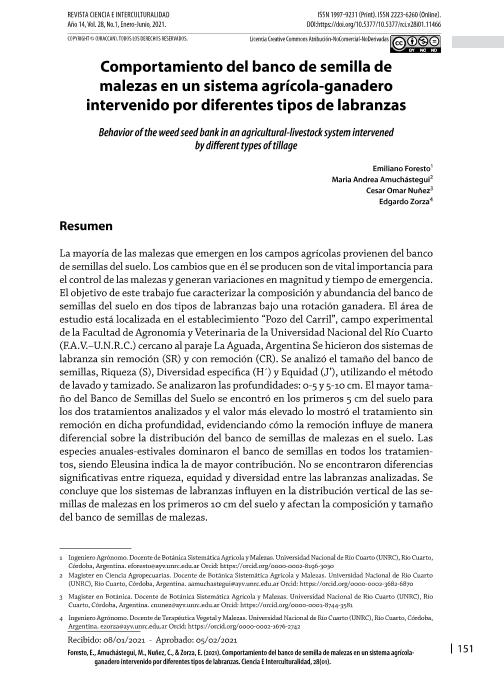Artículo
La mayoría de las malezas que emergen en los campos agrícolas provienen del banco de semillas del suelo. Los cambios que en él se producen son de vital importancia para el control de las malezas y generan variaciones en magnitud y tiempo de emergencia. El objetivo de este trabajo fue caracterizar la composición y abundancia del banco de semillas del suelo en dos tipos de labranzas bajo una rotación ganadera. El área de estudio está localizada en el establecimiento "Pozo del Carril", campo experimental de la Facultad de Agronomía y Veterinaria de la Universidad Nacional del Río Cuarto (F.A.V.–U.N.R.C.) cercano al paraje La Aguada, Argentina Se hicieron dos sistemas de labranza sin remoción (SR) y con remoción (CR) . Se analizó el tamaño del banco de semillas, Riqueza (S), Diversidad específica (H´) y Equidad (J’), utilizando el método de lavado y tamizado. Se analizaron las profundidades: 0-5 y 5-10 cm. El mayor tamaño del Banco de Semillas del Suelo se encontró en los primeros 5 cm del suelo para los dos tratamientos analizados y el valor más elevado lo mostró el tratamiento sin remoción en dicha profundidad, evidenciando cómo la remoción influye de manera diferencial sobre la distribución del banco de semillas de malezas en el suelo. Las especies anuales-estivales dominaron el banco de semillas en todos los tratamientos, siendo Eleusina indica la de mayor contribución. No se encontraron diferencias significativas entre riqueza, equidad y diversidad entre las labranzas analizadas. Se concluye que los sistemas de labranzas influyen en la distribución vertical de las semillas de malezas en los primeros 10 cm del suelo y afectan la composición y tamaño del banco de semillas de malezas. Most of the weeds that emerge in agricultural felds come from the soil seed bank. Te changes that occur in it are of vital importance for weed control and generate variations in magnitude and time of emergence. Te objective of this work was to characterize the composition and abundance of the soil seed bank in two types of crops under a livestock rotation. Te study area is located in "Pozo del Carril" establishment, an experimental feld of the Agronomy and Veterinary Medicine Faculty at the National University of Río Cuarto (FAV-UNRC) near La Aguada, Argentina. removal (SR) and with removal (CR). Te size of the seed bank, Wealth (S), Specifc Diversity (H') and Equity (J') were analyzed, using the washing and sieving method. Depths were analyzed: 0-5 and 5-10 cm. Te largest size of the Soil Seed Bank was found in the frst 5 cm of the soil for the two treatments analyzed and the highest value was shown by the treatment without removal at that depth, showing how removal has a diferential infuence on the distribution of the soil and weed seed bank in the ground. Annual-summer species dominated the seed bank in all treatments, with Eleusina indicating the highest contribution. No signifcant diferences were found between wealth, equity and diversity among the farms analyzed. It is concluded that tillage systems infuence the vertical distribution of weed seeds in the frst 10 cm of the soil and afect the composition and size of the weed seed bank.
Comportamiento del banco de semilla de malezas en un sistema agrícola-ganadero intervenido por diferentes tipos de labranzas
Título:
Behavior of the weed seed bank in an agricultural-livestock system intervened by different types of tillage
Fecha de publicación:
06/2021
Editorial:
Universidad de la Regiones Autónoma de la Costa Caribe Nicaraguense
Revista:
Ciencia e Interculturalidad
ISSN:
1997-9231
e-ISSN:
2223-6260
Idioma:
Español
Tipo de recurso:
Artículo publicado
Clasificación temática:
Resumen
Palabras clave:
Banco de semillas
,
Malezas
,
Labranzas
,
Pasturas
,
Siembra directa
Archivos asociados
Licencia
Identificadores
Colecciones
Articulos (INBIAS)
Articulos de INSTITUTO DE BIOTECNOLOGIA AMBIENTAL Y SALUD
Articulos de INSTITUTO DE BIOTECNOLOGIA AMBIENTAL Y SALUD
Citación
Foresto, Emiliano; Amuchastegui, Maria Andrea; Nuñez, César Omar; Zorza, Edgardo Juan; Comportamiento del banco de semilla de malezas en un sistema agrícola-ganadero intervenido por diferentes tipos de labranzas; Universidad de la Regiones Autónoma de la Costa Caribe Nicaraguense; Ciencia e Interculturalidad; 28; 1; 6-2021; 151-165
Compartir
Altmétricas




